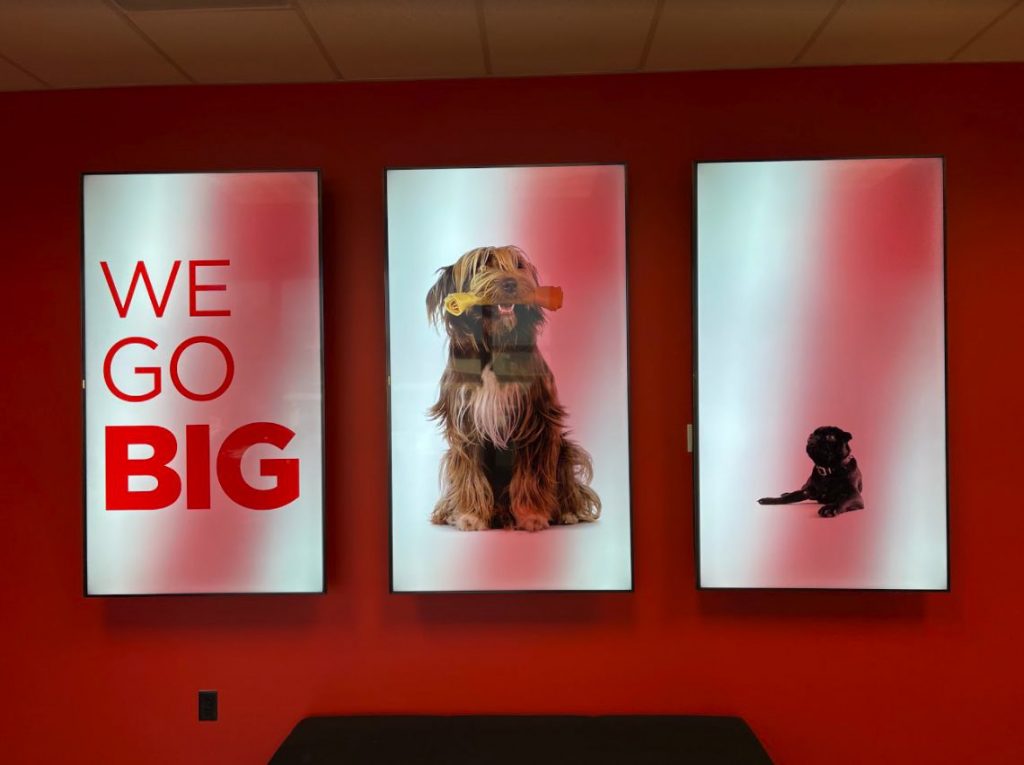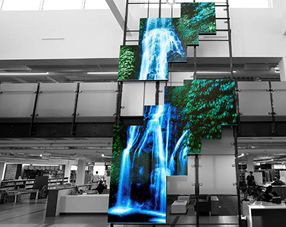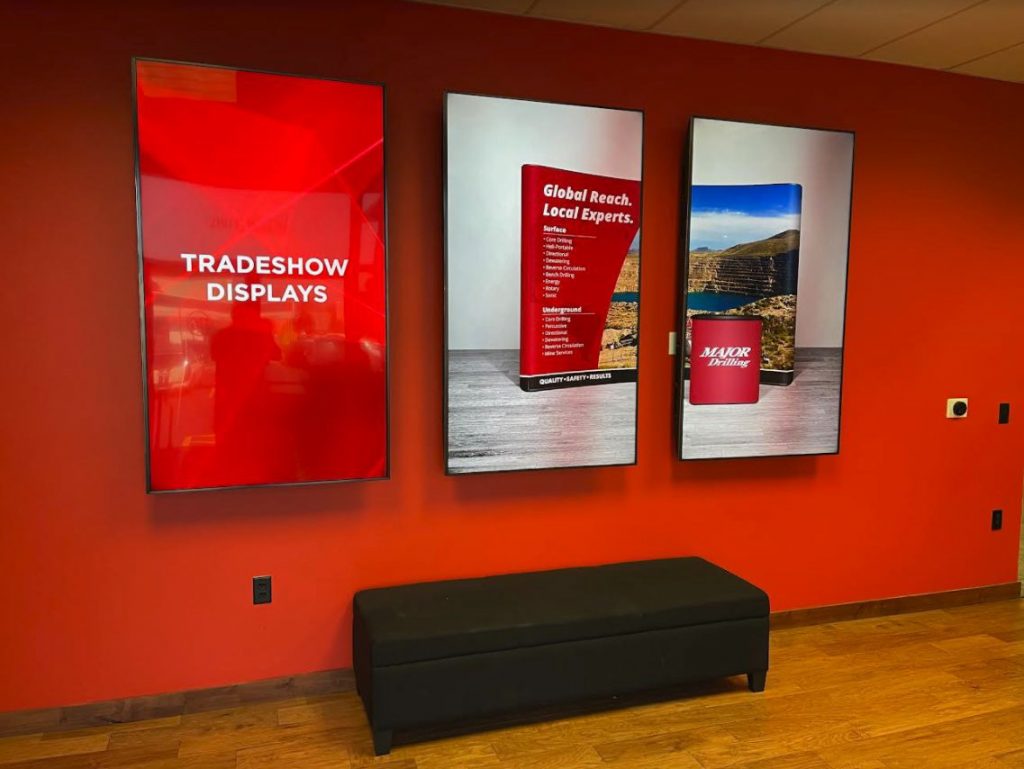Marketing will always be one of the most important investments you will make in your business. Even with top-notch customer service, a superior product or service, and reasonable prices, you can’t attract customers if they don’t know you exist. In our current climate of everything digital, many businesses overlook the marketing they can do right in front of their customers. One area that continues to gain steam in marketing is digital signage.
Signage has been a cornerstone of any physical marketing strategy for decades (or centuries, if you count the very first billboard in ancient Egypt 3,000 years ago). We see signage at work throughout history – from hand-painted signs on storefronts and buildings to printed signs. Billboards have received a number of upgrades over the years, from standalone images to billboards that display multiple ads at once. Smaller signs within stores do everything from advertising the latest special to helping customers navigate the store.
Now, digital signage is contributing to the next era of sign-based advertising. Here’s an in-depth explanation of digital signage for businesses and how you can use it in your marketing.

What is Digital Signage?
Digital signage is a form of electronic signage that can range in size, from entire wall displays to single desktop-sized monitors. Rather than relying on printed media (like a billboard or poster), digital signage receives its information via an internet connection. Content is uploaded directly to the monitor from a content management system (CMS) or even a USB drive, depending on your signage type.
The availability of high-speed internet coupled with the ability to compress large files into smaller sizes is driving the evolution of digital signage. The costs of display technology continue to drop, and new types of displays are continually entering the market. As it becomes more accessible to businesses of all sizes and industries, digital signage’s potential continues to climb, too.
These displays serve a variety of purposes and use cases, from sharing in-store marketing messages to promoting information at an outdoor event. A restaurant might display pictures of special dishes, drinks, and desserts to increase sales. A museum might promote its membership programs and pricing. An office facility might share internal memos and reminders for employees. Or a hotel might display a waterfall or crackling fire in their lobby to add to the ambiance.
The use cases are seemingly infinite for digital signage, particularly from a marketing standpoint. And when used smartly, they can even create multiple streams of revenue (more on that in a moment).
The Building Blocks of Digital Signage
On the surface, users see content projected onto a display. But behind the scenes, there are a lot of components that go into creating these displays and delivering the content to your end-users. Here’s a peek behind the scenes:
- The Display: Depending on your business and needs, you might need individual monitors stationed in strategic locations or entire display walls for events.
- The Software: To create and store your digital signage content, you will need some form of a content management system.
- The Technology: Digital signage content is usually uploaded remotely, which means you’ll need internet connectivity, either a fixed connection or a mobile hot spot.
- The Content: Content is an ongoing expense of digital signage. Keeping the content fresh ensures your signage will continue to add value to your audience.
- The Installation: Every display will need to be installed to ensure safety and functionality. This process can take some strategic planning before making any firm investments.
- The Management: In addition to creating the content, you may also need to assign someone to manage the content and updates to your signage.
Clearly, there’s a lot that goes into building the mechanics of your digital signage. There’s even more that goes into the dynamics of creating a digital signage marketing strategy.
Digital Signage Types to Know
Just as there are tons of types of signage, there are different types of digital signage, too. Choosing the “right” type of signage depends on how you intend to use it (e.g., marketing, wayfinding, etc.), whether you want your displays to be temporary or permanent, and where you intend to display it (indoors or outdoors).
Let’s look at some options:
Indoor Digital Signage
Tailored to indoor environments, indoor digital signage usually takes the form of single monitors mounted to walls or ceilings or installed “in” the wall like a poster. They display everything from advertisements to videos to maps and more and can be used in a variety of settings, including schools, hotels, offices, retail stores, and public spaces.
Outdoor Digital Signage
Outdoor locations are increasingly becoming targets for digital signage. One of the biggest differences between indoor and outdoor signage is the display. Since your outdoor environment will change in terms of lighting (e.g., daytime, nighttime, overcast days, etc.), it needs to be able to display information under varying conditions. They also need to be fully enclosed to prevent water, moisture, and debris from impacting the display.
Freestanding Digital Displays
Freestanding displays are permanent fixtures that aren’t attached to a wall. Rather, they’re more like a kiosk that’s mounted to the floor but serves the same purpose as a wall-mounted display.
Digital Signage Walls
Popular at events or anywhere you want to make a statement, digital signage walls take up large swaths of space. They’re usually a collection of monitors that work together to display a single image or video.

Portable Digital Signage
For temporary signage needs, such as events, there’s portable digital signage. These do not rely on fixed connections and can easily be set up and taken down on demand.
The Business Benefits of Digital Signage
Digital signage in marketing can help to increase sales and deliver a number of benefits to your business. From advertising at scale to lowering customer acquisition costs, digital signage packs a powerful punch to your bottom line. Let’s look at some of the key benefits you can expect from a digital signage strategy.
Add Context to Content
Sell a complicated product? Got a new service you’d like to share with your customers? A video can be a great way to add context and bring it to life for your audience. Your digital signage is another way to promote your video content, be it a product demonstration, explainer video, or anything else that helps your audience “get it.”
Improve Recall
Dynamic content like digital signage displays captures 4x as much attention as static displays. As your content updates on the display every few seconds, the motion catches the eye and pulls the viewer in. Not only does it increase views, but it also improves recall by 200%. Patrons have admitted being pulled into a store because something caught their eye, helping you to increase foot traffic with very little effort.
Speak to Users at Scale
It’s good customer service to speak to every customer as they walk through your doors. But when there isn’t a greeter available or you’re having such a busy day that all of your employees are preoccupied, your digital signage can do the talking for you. Use it to share your daily specials, sales, and promotions that you’d otherwise try to tell your customers in person.
Increase Revenue
From impulse buys to special deals, digital signage plays a direct role in increasing sales. The products you share on your digital signage can put something on your customer’s radar they weren’t intending to buy but simply can’t pass up. These unplanned purchases can really add up, helping you to make back your digital signage investment.
Reduce Printing Costs
From flyers to posters to direct mail, much of the collateral you used to print can now be turned into a digital format. Display company updates and information on your signs to save on printing costs, as well as the space you need to store larger printed materials like posters and menu boards.
As an added bonus, it also reduces the impact on the environment when you have less paper waste.
Customize Your Customer’s Experience
Digital signage gives you another outlet to create unique experiences for your customers and reinforce your brand. The images, text, and videos you display should directly connect to your brand. Use your logo, company colors, and other branding elements to create consistency throughout your digital messages.
Reduce the Workload on Employees
Do your employees answer some of the same questions every day? Are they constantly having to swap out printed flyers and other materials? Digital signage saves time and effort by letting customers help themselves. They can find answers to the most common questions via digital signs, freeing up your employees to engage in more meaningful conversations with customers. They’re more readily available to work on higher-value tasks that will generate sales and loyalty.
And all of this with no gap in customer service. Customers don’t have to be kept waiting for an employee to become available. Studies show that
90% of customers expect an immediate response when they ask a question. Likewise, 90% of customers agree that service will help them decide whether to do business with a company in the future. When customers have ways to quickly address their needs on their own, your business benefits in the process.
Create New Revenue Streams
You can recoup some or all of your digital signage expenses by using it to create new sources of revenue for your company. One way to do this is to increase sales of your products or services. To see just how much your digital signage contributes to your revenue, you might display a special discount code or offer that’s only available through your digital signage, then track redemptions of that offer.
Another option is to sell ad space to other businesses and brands. They can “rent” a spot on your signage to get in front of your audience. It’s more exposure for them and more revenue for your business.
Similar to selling ad space, you might even partner with local businesses to promote them for free. For every customer they get from you, you can collect a fee or a percentage of the sale.

How to Build Your Digital Signage Strategy
Digital signage opens a multitude of new doors for marketers, advertisers, and businesses of all sizes and industries. Now for the big question: how do you go about building your digital signage strategy?
This journey may look a little different for every business, but here are some good places to start:
1. Define Your Ideal End Goals
We covered a lot of examples of how real businesses can use digital signage. You might be attracted to all of them or just a few specific ones. No matter your priorities, it’s a good idea to put them on paper and think long and hard about how you can go from signage to results. Start connecting the dots of your journey to make sure digital signage is the right solution for you.
Some things you might want to consider include:
- What type of content will you need to create?
- Do you have the skills in-house to create your content, or will you need to outsource it?
- How can you track the impact of your digital signage?
- Who will be in charge of updating your content?
This isn’t meant to be an exhaustive list of questions, but it should help you start thinking in the right direction.
2. Explore Your Budget
Like most types of advertising and marketing, digital signage is an investment. You might expect it to give you some form of ROI. Or, you might just want to improve the customer or employee experience. Either way, you need to make sure you’ve got room in your budget for your new undertaking.
So, what exactly do you need to budget for? There’s the cost of equipment (usually a one-time purchase), software and hardware updates, and content creation. You may also need to pay a separate one-time fee to install and test your system. Also, you may want to factor in electricity costs to power your signage.
3. Work with a Dedicated Digital Signage Company
Working with a digital signage company is usually the most cost-effective path, as you end up paying a flat fee for equipment, installation, and management. The company takes the lead in recommending equipment that will best fit your business needs, a process that can become quite complex as you start exploring your options.
Plus, you get ongoing support as part of the package. If your equipment ever stops working, you need to upgrade, or you have questions, you’ll have someone to turn to instead of having to figure it out yourself.
Fully managed solutions give you the most value because your system becomes truly hands-off for you. Instead of relying on an in-house employee to create content, make updates, and troubleshoot equipment, all of this is done for you through your signage partner. They do site surveys to choose the best locations for your signs, and then they will handle all aspects of installing and testing your equipment.
Many fully managed solutions will also give you a dedicated account manager who will learn about your business and know your account inside and out.
4. Deploy, Track, Refine
Once your digital signage system is up and running, your biggest priority becomes deploying, tracking, and tweaking your content. Going back to your original goals, you will create the content to display on your monitors. If you are showing sales, specials, or other promotions, you’ll need to decide whether you want to track conversions from your digital signage, and if so, what that tracking process will look like.
Keeping your signage updated will be your other priority. For instance, if you own a restaurant, your regular guests won’t want to see the same old dishes and drinks being displayed. Inspire them with new images, specials, or even a behind-the-scenes tour of your kitchen.
It can also be beneficial to listen to guests’ comments and reactions to your digital displays. Take note about the content that stops them in their tracks, or the content they might speak negatively about. Use this intel to build on your successes and make your signage even more effective.
Taking Digital Content to New Heights
In 2022, content is still very much the king. It’s a top priority for marketers to share information about their businesses and encourage their customers to act. But the traditional content marketing space is getting crowded. SEO is harder to come by, social media is noisy, and PPC ad costs are at an all-time high. To truly take advantage of all the benefits of content marketing, businesses need to explore new ways to create and share their content and engage their audiences. Digital signage checks all the boxes.
To learn more about digital signage solutions custom-made for your business, get in touch today.